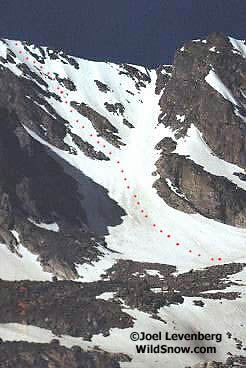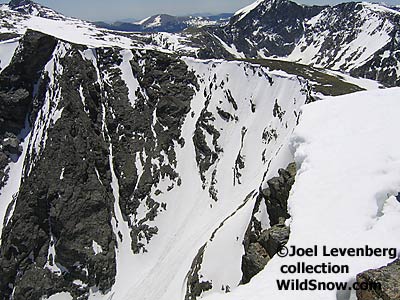Editor’s note: Ski descent rating systems exist, we came up with this new one some time ago to address flaws in the other systems. Good grist for discussion if nothing else. The community has been talking about this on-and-off for years now. Below has always been our rating system example and comment post (originally published in August of 2010), with link to the actual D System rating method page. We’re not sure ski route rating systems will ever catch on in a big way, but they are useful on occasion, and common in European guidebooks.
(Bringing this post up is also a remembrance of Joel, who died in an avalanche in 2011.)
A few years ago the late backcountry snowboarder Joel Levenberg sent this question (edited version below) about the D System. It’s still a good way to focus discussion of the D System (and remember Joel), so here we go…
Taylor Glacier with complete glisse descent route marked. D System II D19 R3
“Lou, I’m curious about your opinion of what D rating would be assigned to Taylor Glacier in Rocky Mountain National Park. I snowboarded it many moons ago and did some slope measurements with a slope meter on the headwall that were beyond 60 degrees.”
“After the first two turns, the slope dropped down to mid to lower 50s and held that for about 400 vertical feet. There were cliffs to negotiate the entire way down. I’m including a pic a friend took recently after climbing it and a pic I took after my descent with my route painted on. Are you familiar with the route and if so what do you think? I’m proposing a II D19 R3. I’m just curious as to what your opinion is.”
Top section of Taylor Glacier, showing 60 degree crux section.
Joel, thanks for an excellent example of the D System in real life. Taylor illustrates the importance of the D Scale crux rating as part of the D System, modified by considering the length of the crux and other factors. The length of the route is rated by the Roman numerals, and the “R” rating indicates the risk/danger. I’d say the grade II for length is close enough, and your R3 is reasonable as a danger rating. An R4 route would probably have items such as more objective hazards, longer steeps, or require skiing within inches of cliff edges.
If the crux is usually as steep as you measured it, that places it in the D 18 or above range. Since the crux is so short I’d be conservative in the rating (a shorter crux is easier than a longer one), but if the difficult part of the route is exacerbated by terrain features you have to work around or over, then that would bump it up. Thus, I’d think saying it’s a D19 would be fine, though it could be a D18 due to how short the crux is. Subsequent descents will gradually refine the rating, as in rock climbing ratings. Main thing and worth repeating over and over, remember that the D System is intended to rate difficulty of descents RELATIVE TO ONE ANOTHER. It’s not a math formula, though it does use things like slope angle numbers to reach general conclusions about where a descent would rate in the total scheme of things. This is explained at length on our D System Page.
Joel, indeed, your example shows how the D Scale of the D System works in similar fashion to rating a rock climbing route using the YDS system (e.g., 5.11, 5.12, etc.), since you rated a route D 19 based on the crux.
More, this example illustrates how difficult it is for any rating system to completely reflect the nature of a route. In the case of the D System, a D19 route requires skill with terrain in the realm of 60 degrees steep. BUT, there is a big difference between a Grade II ski route and a Grade V. Likewise between an R3 ski route and an R4. While one might have the technical skill to ski or snowboard a D19 crux, can she handle that type of terrain if it’s sustained for hundreds or even thousands of feet, as in the case of Mount Robson? What if he’s been climbing for 12 hours before starting the descent? And what if the hazards of the route are causing extreme mental stress (otherwise known as fear?). Since the D System has a length and danger rating it addresses these concerns, but deciding whether to do a route or not will always require more than simply knowing a rating. As is the case with rock climbing. Thus, it’s important to include the length and danger rating along with the D Scale rating.
A while ago someone mentioned we should include the length of the crux in the D System rating. We felt that was getting too far over on the narrative side of things for a tight rating system. In other words, when does a rating become a guidebook description? Any rating system requires support from things like other people’s experience and guidebook descriptions. D System is intended to be tight and brief.
(Note, Taylor Glacier can be skied or snowboarded from lower down for a more moderate descent, and is frequently done that way. More, various starts are obvious in the photo and these could require different D Scale ratings if it’s common to pick between them.)
WildSnow.com publisher emeritus and founder Lou (Louis Dawson) has a 50+ years career in climbing, backcountry skiing and ski mountaineering. He was the first person in history to ski down all 54 Colorado 14,000-foot peaks, has authored numerous books about about backcountry skiing, and has skied from the summit of Denali in Alaska, North America’s highest mountain.
Rating Ski Descents – D System
previous post


